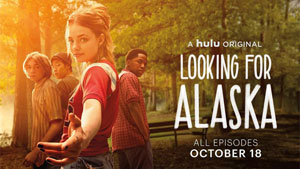The eight-episode Hulu series “Looking for Alaska” shatters the Manic Pixie Dream Girl trope while also being one of the best MPDG stories ever told. Walking a delicate tightrope from start to finish, showrunner Josh Schwartz (“The O.C.,” “Gossip Girl”) – who writes or co-writes five of the eight episodes – gives us the teen male perspective of Miles “Pudge” Halter (Charlie Plummer). Through his eyes, Alaska Young (Kristine Froseth) is beautiful, quirky and mysterious. Yet — without sacrificing those ethereal qualities that Pudge might be projecting onto his first love/lust — “Looking for Alaska” also makes Alaska into a fully realized person.
The miniseries is based on the debut novel by John Green, and it’s set in 2005, the year of the book’s release. All eight episodes are packed with beauty as Miles attends a private school in Alabama that has the vibe of a summer camp. Granted, the early episodes include an undeniable amount of pretentiousness; we are, after all, talking about teenagers in a Green adaptation. The successful “Fault in Our Stars” (2014) and less-successful “Paper Towns” (2015) also walk this fine line: teenagers mull the meaning of life and death as they get acquainted with both.
But the great cast keeps us engaged. Plummer is an Everyteen with one quirk: Pudge is fascinated by people’s last words. His first friend is his assigned roommate, Chip “The Colonel” Martin (Denny Love). The Colonel gives Miles his ironic “Pudge” nickname because Miles is skinny. The Colonel is one of those oh-so-smart kids who is equal parts unreal and unlikable. Yet I quickly grew to like him anyway.
Takumi (Jay Lee) is a laid-back yet steadying force among the friends, Lara (“Medium’s” Sofia Vassilieva) is a cutie with a thick Romanian accent, and Alaska is the aforementioned MPDG.
All the MPDG traits we know from “Garden State’s” (2004) Sam and “Elizabethtown’s” (2005) Claire are accounted for. Alaska brings Miles out of his shell and guides him down certain paths of behavior and interests with her seemingly flighty approvals and dismissals. It’s obvious right away that to go down the Alaska path means heartbreak for Pudge, and as such, I was seriously shipping Pudge and Lara.
Froseth’s physical beauty and magnetic smile make us understand Pudge’s crush, but simultaneously, the writers build Alaska into a complete person. We learn all about her: She loves books, she smokes and drinks too much, she can immediately make friends and is a great judge of people, she has a college boyfriend, she rails against the patriarchy but doesn’t hate men, and she sees life as a “labyrinth.” And we eventually learn a key component about her past.
I knew we would not get a happy Pudge-and-Alaska ending not because the series telegraphs heartbreak — like, for example, how “(500) Days of Summer” tells us “This is not a love story.” Rather, “Alaska” simply has a wider canvas than a movie romance.
Every episode is about the friendship between the core quartet, with Lara sometimes a fifth member. Their cigarette-smoking hangout spot at Culver Creek High – a deck under a river bridge – is unlike anything I’ve seen elsewhere, giving “Alaska” its own sense of place.
The plots, such as they are, are driven by the ongoing prank war between our heroes and the Weekday Warriors, the rich kids who go home on weekends to their families and air conditioning. One prank involves our gang dosing the WWs with laxatives that kick in during a cotillion. “Alaska” doesn’t go as far with this gag as “American Pie” or its ilk, as if it’s saying “This is not a crude show, it’s a classy show.”
The prank war notwithstanding, the events are often mundane, including a school dance, a Thanksgiving dinner, and Pudge and Alaska chatting with their wise comparative religions teacher Mr. Hyde (Ron Cephas Jones of “This Is Us”). These sequences would be boring if they weren’t so good. The events are always about people living and reflecting on their lives – and the intrinsic bizarreness of the fact that we all live and die without learning a core “meaning of life” — and I grew to love the series on that level. It’s like “This Is Us,” but never with any sense that it’s trying too hard.
There’s also a mystery playing behind the first six episodes. “Alaska” begins by showing glimpses of a horrific car crash, then flashes back to the fall semester at Culver Creek. Each episode ends by telling us it’s a certain number of days before the accident. “Does someone die in that crash?,” we wonder. “And if so, who?” The two post-crash episodes then pivot to a related mystery.
Oddly, I rarely thought about the crash mystery. But inasmuch as it blends in with the question of “Who is Alaska?,” Schwartz’s series has a propulsive quality that comes from the kids (and adults – Hyde doesn’t pretend to have the answers) mulling big questions.
The questions of “Alaska” are fresh enough to these teens that I got pulled into their various quests, be it searching for a good prank idea or for the meaning of existence. The 2005 setting, accented by the wonderful music from that “Lost Decade” that I almost forgot about (I even forgive one shameless “Garden State” lift), is wisely chosen. These millennials aren’t as dramatic as the Angela Chases and Dawson Leerys of the previous decade, but nor are they as prematurely world-weary as Gen-Z teens of, say, “Chilling Adventures of Sabrina.” Maybe they grow up to be annoying adults, but that’s not at issue here.
“Looking for Alaska’s” teens are real people who grow out of an archetypal foundation. The series is impressive all around, and in the case of the titular MPDG (or anti-MPDG), it might be groundbreaking.


